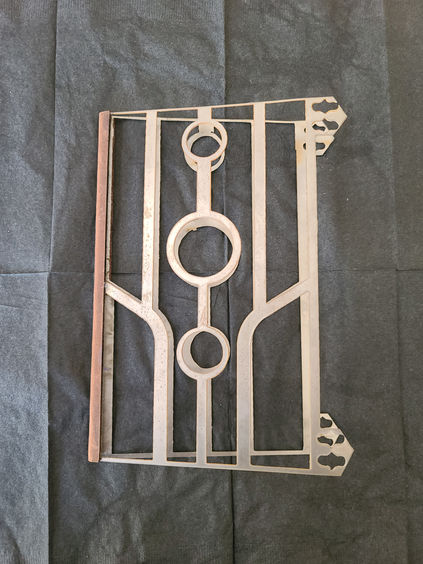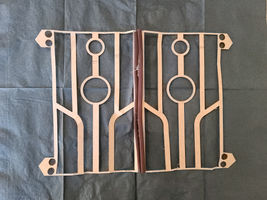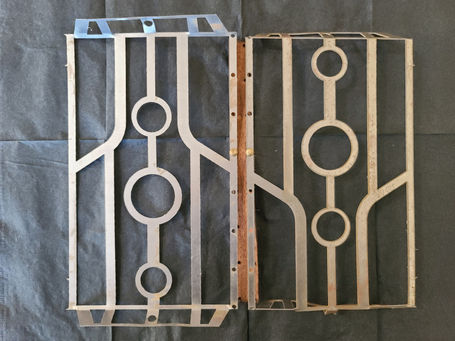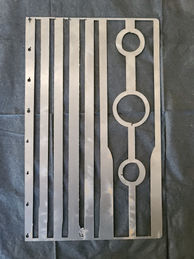For this project, I wanted to create an accessory that could bring more interest to the act of journaling. In my time at Lehigh, I noticed that people who recorded their thoughts used cheap soft cover journals with little to no decorative elements. As such, to make journaling look more appealing to non-creatives, I imagined ways to improve upon and restyle the process of using a soft cover journal. This resulted in the concept of a decorative metal cover system that could add visual intrigue to any soft cover journal while also providing a person their own hard surface to utilize anywhere.
My covers’ design took inspiration from the Art Deco era. This is because art within this style period often centered around themes of optimism and idealism, which I believed would help the product inspire more people to explore their thoughts and reflect more sincerely. Art Deco designs often featured symmetry, layered shapes, and intricate line art that balanced rectilinear geometry with curves. It also featured metal coloring, which reaffirmed my choice of material. Once I created a dynamic design that upheld these parameters, I explored ways to connect the covers to each other and the journal. For the former, I chose to incorporate a leather spine with metal rivets that would allow the journal to expand regularly while providing visual contrast; for the latter, I added a pair of flaps to each cover that would bend to hold the journal in place. With my direction solidified, I then used a local water jet cutter and sheet metal I purchased from a Bethlehem hardware store to create cover prototypes and test their designs.
Cardstock and Sheet Metal Cover Prototype Process
It took over ten iterations for my design to function as I originally envisioned. Many of these prototypes attempted to solve issues surrounding the flap connectors. This is because the sheet metal for this feature, while it was able to bend enough to hold a journal cover, would break due to the stress on its weaker structural points. Other times, the bend would expose sharp contact points in the cover’s side profile, prompting a redesign that addressed this issue. However, none of these iterations completely resolved the issue of structural strength and longevity while also adhering to my design’s focus on symmetry and precision. Additionally, I was struggling to create a leather spine of comparable quality to the metal covers. Even when I was able to laser cut a properly dimensioned spine with rivet holes, the final product looked lackluster when paired with its metallic counterpart. In addition, pieces of the leather not bolted down from rivets popped up constantly when the journal was not in use, impeding my design’s goal of seamless integration between leather and metal. For these reasons, I scrapped the leather spine element and instead prioritized how to improve the metal covers’ ability to stay attached to the journal.
My breakthrough would come from incorporating an ignored aspect of a soft cover journal’s composition into my design: its flexibility. Whereas before my prototypes tried to encase the journal with its features, now the journal itself was a vital part of the design: I realized I could bend and slot the journal’s soft covers in between my metal covers, which would allow the two elements to hold together firmly. This design choice also had the benefit of utilizing the journal’s spine in lieu of my own fabricated solution, both simplifying the design and giving each element openings to be appreciated. Once I tested this slot idea for its feasibility, I modified my original design to determine how to best incorporate slots. After exploring a couple options, my final design would feature two pairs of slots on each side of a metal cover. This would ensure a tight fit while also allowing the original journal cover to stretch over the enclosed pages. This redesign also included rounded edges for the metal covers to minimize sharp areas. Once these changes were finalized, I sent my design to be professionally cut at Trexler Industries, a Bethlehem machining plant that would allow my design to look as refined as possible before its final assembly. It was here that I elected to make my final material .04-inch Aluminum, as it was light and thick enough to eliminate any chance for accidental cuts; I also chose to make an accompanying stencil for each set of covers using the leftover aluminum at my disposal.
Final Cover Prototype
This project gave me the chance to create a solution that addressed a soft cover journal’s weakness while highlighting its strengths. I was also able to inject new life into the concept of journaling and, through my collaboration with local vendors, create a polished product that is more impactful than I could have achieved alone. In fact, this can be observed through my ability to sell an inventory of 15 journals with metal covers at a local Bethlehem art show and leave with a profit of 40 USD, validating that my product and its design can generate interest in journaling.
















